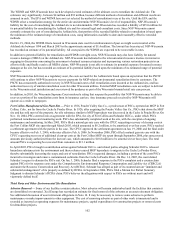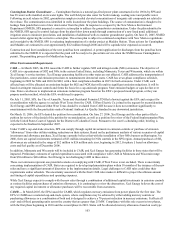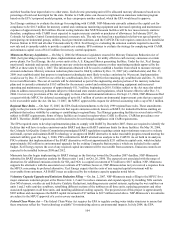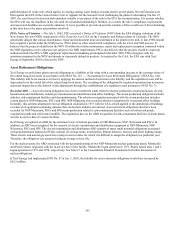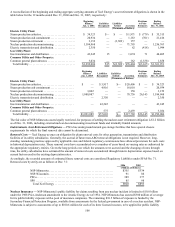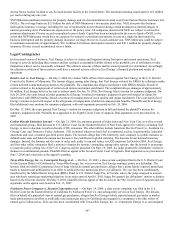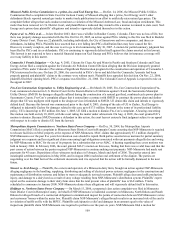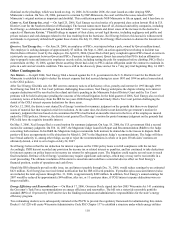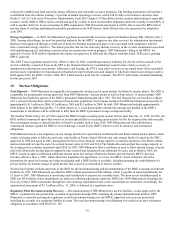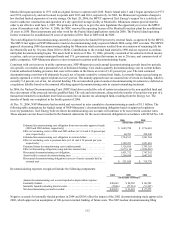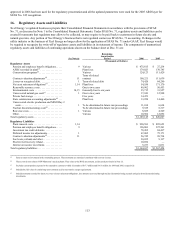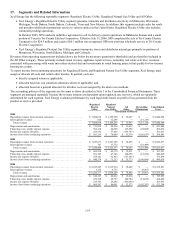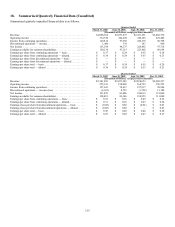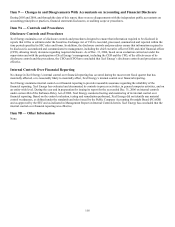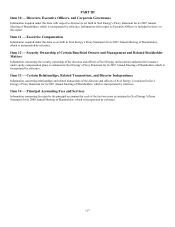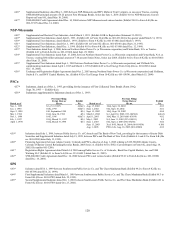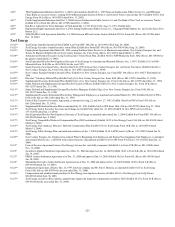Xcel Energy 2006 Annual Report Download - page 121
Download and view the complete annual report
Please find page 121 of the 2006 Xcel Energy annual report below. You can navigate through the pages in the report by either clicking on the pages listed below, or by using the keyword search tool below to find specific information within the annual report.111
collectively establish and fund statewide energy efficiency and renewable resource programs. The funding mechanism will include a
contribution from the utilities totaling 1.2 percent of annual operating revenues, which will be fully recoverable in customer rates.
Docket 1-AC-221 will revise Wisconsin Administrative Code PSC Chapter 118 that allows for the creation and tracking of renewable
resource credits (RRCs). RRCs can be created and used by a utility to meet its renewable obligation under the recently revised RPS, or
sold to another utility for its use in meeting its RPS requirement. NSP-Wisconsin anticipates it will be able to meet the RPS with its
pro-rata share of existing and planned renewable generation on the NSP System. Both of these rules are expected to be adopted in
early 2007.
Energy Legislation — In 2005, the Minnesota Legislature passed and the Governor signed an Omnibus Energy Bill, effective July 1,
2005. Among other things, the new law provides authority for the MPUC to approve rate rider recovery for transmission investments
that have been approved through a certificate of need, the biennial transmission plan, or are associated with compliance with the
state’s renewable energy objective. The statute provides that the rate rider may include recovery of the revenue requirement associated
with qualifying projects, including a current return on construction work in progress. NSP-Minnesota’s filing to the MPUC for
approval of a new TCR tariff to implement this statute was approved in 2006 and the filing to establish initial TCR rates is pending
MPUC approval.
The 2005 Texas Legislature passed a law, effective June 18, 2005, establishing statutory authority for electric utilities outside of the
electric reliability council of Texas in the SPP or the Western Electricity Coordinating Council to have timely recovery of
transmission infrastructure investments. After notice and hearing, the PUCT may allow recovery on an annual basis of the reasonable
and necessary expenditures for transmission infrastructure improvement costs and changes in wholesale transmission charges under a
tariff approved by the FERC. In Dec. 2006, PUCT Staff issued a draft rule for comment. The PUCT will initiate a formal rulemaking
for this process in 2007.
15. Nuclear Obligations
Fuel Disposal — NSP-Minnesota is responsible for temporarily storing used or spent nuclear fuel from its nuclear plants. The DOE is
responsible for permanently storing spent fuel from NSP-Minnesota’s nuclear plants as well as from other U.S. nuclear plants. NSP-
Minnesota has funded its portion of the DOE’s permanent disposal program since 1981. The fuel disposal fees are based on a charge
of 0.1 cent per kilowatt-hour sold to customers from nuclear generation. Fuel expense includes the DOE fuel disposal assessments of
approximately $13 million in 2006, $12 million in 2005 and $13 million in 2004. In total, NSP-Minnesota had paid approximately
$360 million to the DOE through Dec. 31, 2006. However, it is not determinable whether the amount and method of the DOE’s
assessments to all utilities will be sufficient to fully fund the DOE’s permanent storage or disposal facility.
The Nuclear Waste Policy Act of 1982 required the DOE to begin accepting spent nuclear fuel no later than Jan. 31, 1998. In 1996, the
DOE notified commercial spent-fuel owners of an anticipated delay in accepting spent nuclear fuel by the required date and conceded
that a permanent storage or disposal facility will not be available until at least 2010. NSP-Minnesota and other utilities have
commenced lawsuits against the DOE to recover damages caused by the DOE’s failure to meet its statutory and contractual
obligations.
NSP-Minnesota has its own temporary on-site storage facilities for spent fuel at its Monticello and Prairie Island nuclear plants, which
consist of storage pools at both sites and a dry cask facility at Prairie Island. With the dry cask storage facility licensed by the NRC,
approved in 1994 and again in 2003, management believes it has adequate storage capacity to continue operation of its Prairie Island
nuclear plant until at least the end of its current license terms in 2013 and 2014. The Monticello nuclear plant has storage capacity in
the storage pool to continue operations until 2010. In 2005, NSP-Minnesota filed a certificate of need to allow interim storage of spent
fuel at the Monticello nuclear plant to support license renewal and operation for an additional 20 years, and in October 2006, the
MPUC issued its approval allowing additional interim spent fuel storage. Minnesota Statutes provide that the MPUC decision
becomes effective June 1, 2007, which allows the legislature the opportunity to review the MPUC action if desired. All of the
alternatives for spent fuel storage are being investigated until a DOE facility is available, including pursuing the establishment of a
private facility for interim storage of spent nuclear fuel as part of a consortium of electric utilities.
Nuclear fuel expense includes payments to the DOE for the decommissioning and decontamination of the DOE’s uranium-enrichment
facilities. In 1993, NSP-Minnesota recorded the DOE’s initial assessment of $46 million, which is payable in annual installments for
15 years to 2007. NSP-Minnesota is amortizing each installment to expense on a monthly basis. The most recent installment paid in
2006 was $4.9 million; future installments are subject to inflation adjustments under the DOE rules. NSP-Minnesota is obtaining rate
recovery of these DOE assessments through the cost-of-energy adjustment clause as the assessments are amortized. Accordingly, the
unamortized assessment of $3.7 million at Dec. 31, 2006, is deferred as a regulatory asset.
Regulatory Plant Decommissioning Recovery — Decommissioning of NSP-Minnesota’s nuclear facilities, as last approved by the
MPUC, is planned for the period from cessation of operations through 2050, assuming the prompt dismantlement method. NSP-
Minnesota is currently accruing the regulatory costs for decommissioning over the MPUC-approved cost-recovery period and
including the accruals in a regulatory liability account. The total decommissioning cost obligation is recorded as an asset retirement
obligation in accordance with SFAS No. 143.



